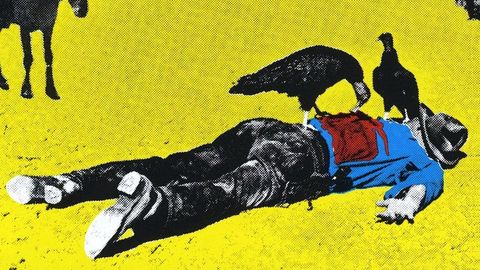The accepted wisdom on Give Em Enough Rope is that CBS brought in a big-name American producer – a guy from one of those dinosaur rock bands they so despised – in an attempt to turn them into Journey or Toto.
In fact, producer Sandy Pearlman was no real big name. Before The Clash, he’d produced his band of outlaw weirdos Blue Oyster Cult, a Mahavishnu Orchestra live album, the first three albums by The Dictators and a Pavlov’s Dog record. And Rope was no big sell-out either – that is, the sound didn’t change dramatically, there were no radio hits – it was just a better-produced (if less inspired) follow up to their debut.
While that first album was brilliantly parochial in its concerns, Rope widened the scope a little. Musically its feet were still planted firmly in the London punk scene, but lyrically it’d been reading the International section of the papers – or a Jack Higgins novel, at least.
In his determination to avoid soppy old love songs, Strummer’s lyrics can sometimes come across as slightly immature Boy’s Own adventures – songs about soldiers, drug-dealers, civil war, mercenaries, street gangs and terrorists. These are the songs that later got The Clash labelled ‘macho’ in some quarters and they are undeniably ‘boy-sy’. To call them ‘macho’, though, is to be lazily iconoclastic.
There’s the self-mocking Safe European Home, for example, with its story of Strummer and Jones’s trip to Jamaica (‘I went to the place where every white face is an invitation to robbery/An’ sitting here in my safe European home/I don’t wanna go back there again’) – it isn’t exactly swaggering braggadocio.
And it’s almost unthinkable in this era of bling and social media boasts that a hot young band would write a song like Cheapskates, about what it’s like to be famous but skint (‘Just because we’re in a group/You think we’re stinking rich… An’ you think the cocaine’s flowing/Like a river up our noses’). It’s sensitive, too. Jones’s bromantic ode to lost friendship, Stay Free, is one of the highlights: musically tender and lyrically heartfelt, even if it is all about getting expelled, shooting pool and doing time. Elsewhere, male violence is castigated, drug-use ends in jail time and Julie – the only significant female in the whole narrative – gets the last laugh.
So, yeah, it’s a man’s world but c’mon: boys need songs too. To a generation of young men, it was exactly what they wanted from their rock’n’roll – not bullshit about princesses, castles and wizards, not bustles in hedgerows and stairways to heaven, but stuff they could relate to.
The Clash spoke to us in language we could understand (it’s hard to imagine any other major league band getting away with a chorus like ‘All the young punks, laugh your life/‘Cos there ain’t much to cry for/All you young c*nts, live it now/‘Cos there ain’t much to die for’ – The Clash’s audience sang along in full voice) and Pearlman brought a fuller, multi-tracked sound to the band, aided in no small part by the arrival of drummer Topper Headon: his aggression is Tommy Gun’s saving grace and his musicality on tracks like Julie’s Been Working For The Drug Squad gave notice as to where the band could go next.
(Note: I have a theory that certain brilliant albums are always destined to be overlooked because they came in such godawful sleeves – packages that only a mother could love. Give Em Enough Rope is Exhibit A in this theory. The only Clash album not to feature the band on the sleeve (until Cut The Crap, if we’re counting that), Rope features a garish sleeve designed by Hugh Brown – though the official album credit goes to CBS in-house designer Gene Greif – of the body an American cowboy getting eaten by vultures while a Chinese horseman looks on.
Presumably a comment on capitalism from a band still ‘so bored of the USA’, it lacks the iconography of the debut (That picture! That logo! That green!), London Calling (that picture!) or Combat Rock (the military type, the Vietnam-chic). No-one’s putting the cover of Rope on a t-shirt or buying the poster for their wall and that certainly hasn’t helped the album’s standing over the years.)

The Clash Albums Ranked From Worst To Best – The Ultimate Guide


